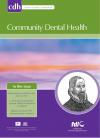Community Dental Health

- Cover Date:
- September 2007
- Print ISSN:
- 0265 539X
- Vol:
- 24
- Issue:
- 3
Editorial - The positive and negative impacts, and dangers of the Impact Factor
The journal impact factor (IF) is widely used but surrounded by considerable controversy. It is important to restrict it to only its appropriate use. The IF can reasonably be useful for evaluating a journal, but even then can be influenced by many factors such as the number of review papers, letters or other types of material published, variations between disciplines, and various biases. The extent to which the IF is appropriate for the evaluation of the quality of an individual, department or institution however, is undoubtedly highly debatable.
Introduction
“Publish or perish†is a well-worn phrase in research in dentistry as in other life sciences, and is fully discussed elsewhere (http://www.harzing.com/pop.htm). The growing importance of research publications is the source of intense and increasing debate, and is strongly influencing the lives of academics in most fields. There is a tremendous drive to assess quality, and this is easiest to attempt to achieve when there is some tangible product such as a research or scientific paper. However, the importance of papers (or journals), and the real impact of these on users and the specialty in the long term is extremely difficult, if not impossible, to judge. One attempt to evaluate the impact of a journal is by use of the Impact Factor (IF), developed in USA by Eugene Garfield of the Institute for Scientific Information (the ISI) (Garfield 1972, 1986,http://www.isinet.com/essays/ journalcitationreports/7.html/). The IF has become widely used and, although there may be some advantages in its use, there has equally been concern already expressed about the use of IF in dentistry (Scully & Lodge 2005). There is a huge debate elsewhere, much of which is summarized below. The IF is published every year so, say in June 2007, the IF for a journal for 2006 would have been calculated from the number of citations in the year 2006 to articles published in the journal in 2004 and 2005, divided by the number of articles published in the journal in 2004 and 2005. The IF is published by a private, profit-oriented commercial US-based organization, Thomson Scientific http://scientific.thomson.com/free/essays/journalcitationreports/impactfactor/ (formerly the ISI; http:// www.isinet.com, http://portal.isiknowledge.com/portal. cgi?DestApp=JCR&Func); access to the databank is not free of charge. When the IF is calculated, the numerator is the total number of citations to virtually any item in the journal, and so all types of articles, such as editorials, letters and abstracts from meetings are included as cited items. In contrast, the denominator is the number of peer-reviewed items only and includes only normal articles, and reviews – not letters or abstracts.
Uses of impact factor
The IF can be helpful to evaluate a journal’s relative “importanceâ€, especially when compared to others in the same field. The IF, along with other criteria, are sometimes used to compare, evaluate and rank journals; indicate the largest journals, the “hottest†journals, what publications a journal cites and which publications cite the journal itself. Publishers often use IF for marketing (many fliers give the journal IF) or in identifying opportunities for new journals or in taking decisions as whether to expand, merge or discontinue existing journals. Authors sometimes use the IF to decide where to publish and to discover other journals in their specialty. Other uses (and misuses) of the IF are discussed below.
Definitions
The idea underlying the IF is citations - the papers and book chapters listed in the references at the end of a scientific paper, and the number of them. The IF is a measure of the frequency with which the “average article†of a journal has been cited in a particular year or period (though clearly, as discussed below, there can be no such thing as an “average articleâ€). The IF is calculated by dividing the number of current citations to articles published in a specific journal in the previous two-year period, by the total number of articles published in the same journal in the corresponding two-year period defined by the ISI (Table 1).
Correspondence to: Style: Professor Crispian Scully, Dean and Director of Studies and Research, Eastman Dental Institute, UCL, 256 Gray’s Inn Road, London WC1X 8LD. E-mail: c.scully@eastman.ucl.ac.uk
- Article Price
- £15.00
- Institution Article Price
- £
- Page Start
- 130
- Page End
- 134
- Authors
- Crispian Scully
Articles from this issue
- Title
- Pg. Start
- Pg. End
- The prescription and outcomes of fissure sealants applied to a group of high caries risk children by general dental practitioners working in the North West of England
- 135
- 139
- Assessment of orthodontic treatment needs in Brazilian schoolchildren according to the Dental Aesthetic Index (DAI).
- 145
- 148
- Dental caries in 5-year-old children attending multi-ethnic schools in Greater Glasgow – the impact of ethnic background and levels of deprivation
- 161
- 165
- Cross-cultural adaptation of the Oral Health Impact Profile (OHIP) for the Malaysian adult population.
- 166
- 175
- Reduction of caries in rural school-children exposed to fluoride through a Milk-Fluoridation Programme in Araucania, Chile
- 186
- 191
- Getting through Dental Fear with CBT: A young person’s guide. Helen Chapman and Nick Kirby-Turner. ISBN 1-904127-07-X. Blue Stallion Publications, Oxon. £4.95
- 192
- 192
